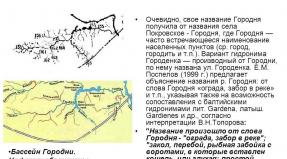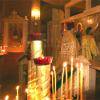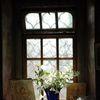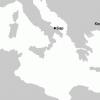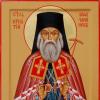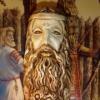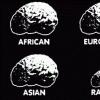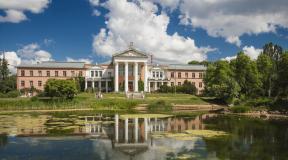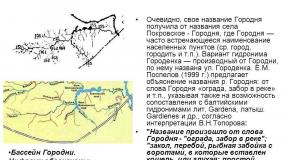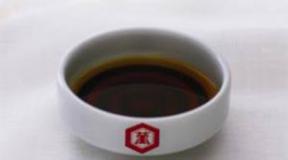Unusual places and monuments. Apostle Andrew the First-Called and Kyiv sights associated with his name
A man is crucified on a cross near the Moscow Ring Road. It is located a little deep, and the driver’s gaze, focused on the road, does not immediately notice it. But once you see it, the impression is so strong that you want to stop. But it doesn't work. The inexorable stream of cars carries you further. And the man on the cross is a thorn in the brain. Who is this? Why?
Then the man on the cross is gradually forgotten. And suddenly, accidentally driving by, again, like a shot to the brain - it’s him! And again the flow of cars dictates its own rules. Either a traffic jam from which you cannot emerge, or a speed of 100 km/h and persistent car horns and winking headlights from behind. We passed again...
One day we realized: the crucified man near the Moscow Ring Road will not let us go. And we went to him specifically. Slowly dragging along the right side and looking for at least some area nearby so that you can turn on the emergency lights and then continue on foot. We were lucky: there was a small “pocket” right next to the cross. We have come to you, Man on the Cross...
To the question “why?” answers the inscription on the stone base.
To the question “who?” The sign just above answers.
The monument depicts the martyrdom of the crucified holy apostle Andrew the First-Called. This is a symbol of the suffering of the people repressed in the 30s who built the Moscow Canal. At this place there was a camp for the repressed, and at this place they were buried. The monument was erected on December 13, 2006 at the 76th kilometer of the Moscow Ring Road in the Khimki Forest Park, right next to the ring road.
“It happened that the prisoners, exhausted and exhausted by back-breaking labor, fell into pits together with their wheelbarrows, fell into the concrete and remained walled up in it. In some cases, the “goners” were taken to camp hospitals, but their days were already numbered. Dmitlag orderly G. Dolmanov recalled that some of the prisoners were buried while still alive. At first, doctors named the real reasons that led to death, but then they were forbidden to do so. Every morning, rakes loaded with corpses left Dmitrov, Yakhroma, Orevo, Dedenev, and Iksha. Mass unmarked burials of prisoners were held in the forests. Sometimes the dead “Dmitlagovites” were buried on the outskirts of cemeteries. In winter, the corpses were placed in stacks at the bottom of a dug hole, sprinkling another “layer” with sand, and the grave was left unfilled until the next day.” .

Dmitlag, the largest camp association of the OGPU-NKVD of the USSR, existed from 1932 to 1938 and was located on the territory of the Moscow region and partly even in Moscow itself. Originating from the Soviet punitive system, Dmitlag was created to use prison labor for the construction of the Moscow-Volga canal.



The monument with the crucified Apostle Andrew the First-Called was made on the initiative of the famous singer Vika Tsyganova and her husband Vadim Tsyganov.

The crucified man on the Moscow Ring Road makes a very strong impression. And if you dig even a little into history, the impression becomes tragic and devastating. It is recommended to stop and look, even if you are in a hurry.
Electronic media "Interesting World". 06/22/2013
Dear friends and readers! The Interesting World project needs your help!
With our personal money we buy photo and video equipment, all office equipment, pay for hosting and Internet access, organize trips, write at night, process photos and videos, type up articles, etc. Our personal money is naturally not enough.
If you need our work, if you want project "Interesting World" continued to exist, please transfer an amount that is not burdensome for you to Sberbank card: Mastercard 5469400010332547 or at Raiffeisen Bank Visa card 4476246139320804 Shiryaev Igor Evgenievich.
Also you can list Yandex Money to wallet: 410015266707776 . This will take you a little time and money, but the magazine “Interesting World” will survive and delight you with new articles, photographs, and videos.
Driving along the Moscow Ring Road, motorists most often see a rather dull picture. Who would have thought that at the 76th kilometer there is a monument to the Holy Apostle Andrew the First-Called, or rather, his crucifix.
The sculpture was made on the initiative of the sculptor, poet, composer Vadim Tsyganov and his wife Victoria (yes, that same singer Vika Tsyganova!) with the active participation of the administration of the Khimki city district and its head of the city V.V. Strelchenko. The consecration was performed by the abbot of the churches of the Dolgoprudny-Khimki district Vladimir (Denisov).
In an interview with “Evening Moscow” on November 24, 2011, Vadim Tsyganov said: “The monument was erected on December 13, 2006, on the day of remembrance of the Apostle Andrew the First-Called. In 2005, I created monuments to the apostle on the Kuril Island of Iturup and on the Crimean Cape Fiolent (in bronze they were embodied by the sculptor Andrei Smirnov). And then my mentor, Archimandrite Iliy, told me that a monument to St. Andrew should appear in Moscow. I was taken aback: who would allow me? I turned to the vice-president of the Military Brotherhood Foundation, Dmitry Sablin, and "he went to the then head of the Khimki city district, Vladimir Strelchenko. And the monument appeared a stone's throw from the capital's border, on the banks of the Moscow Canal, among the builders of which there were many political prisoners - martyrs for the faith like St. Andrew."
The place was not chosen by chance. Not far from the Khimki Reservoir, the Moscow Canal originates, which in the 30s of the twentieth century was built by repressed people, many of whom could not withstand the backbreaking labor and died while working. They were buried in a common grave, which was located on the very spot where the monument is now erected.
In 2013, the 1025th Baptism of Rus' was celebrated and the cross of St. Andrew the First-Called was brought to our country for the first time. People lined up in kilometer-long queues just to venerate the shrine. But the monument to St. Andrew the First-Called on the Moscow Ring Road remains virtually unknown. But this Apstol has a special meaning for Russia.
Father Sergius (Poltavtsev), rector of the Temple of Alexander Nevsky, says: “Andrew the First-Called was given northern lands for preaching. He arrived on the Black Sea, on the Dnieper. He walked through the places where Kiev is now. He uttered the following words: “here there will be a city with many churches, and in general the northern lands will be illuminated by the word of Christ." He is the patron of our land, he left his blessing here."
By the way...
It was the St. Andrew's X-shaped cross that served as the basis for the creation of the St. Andrew's flag of the Russian Navy.
In honor of St. Andrew the First-Called, the first Order of Russia was established, the highest award of the Russian Empire until 1917. On July 1, 1998, by decree of Russian President Boris Yeltsin, the order was restored as the highest award in Russia. In June 2008, at a Sotheby's auction, a diamond star for the Order of St. Andrew the First-Called was sold for $5.4 million, which became an absolute record not only for Russian awards, but for orders in general.
The custom of tying newborn boys with a blue ribbon and newborn girls with a red one goes back to the decree of Paul I to award each born Grand Duke at baptism with the Order of St. Andrew the First-Called, and the Grand Duchesses with the Order of St. Catherine.
And Kvariati. In this article we will talk about how we visited the waterfall, show our own photos and videos and tell you how to get to the waterfall by public transport or during a great holiday.
Our photos and review of the waterfall of St. Andrew the First-Called near Sarpi
We visited this place during . We only had 10-15 minutes to explore the waterfall and take photos, but there really wasn’t anything to do there for longer.
The waterfall, in our opinion, is quite beautiful, but still very inferior to the one we visited next. The statues in honor of the Saint, made in an unusual style, seemed interesting.
In this photo you can see the statue of St. Andrew, a waterfall and a sign with the inscription “The path through Georgia is the path of enlightenment. The project is dedicated to the arrival of St. Andrew the First-Called in Georgia,” performed in Georgian and English.
Let’s add a few more beautiful photos of the waterfall so that you will want to come and see it with your own eyes:
Who is the waterfall dedicated to - a brief historical background
 The statue at the waterfall is dedicated to Saint Andrew. Locals say that it is the Saint who is depicted, protecting Georgia from invaders and troubles with his palm.
The statue at the waterfall is dedicated to Saint Andrew. Locals say that it is the Saint who is depicted, protecting Georgia from invaders and troubles with his palm. Next to the waterfall there is a fairly large sign with inscriptions in Georgian and English. It translates roughly like this: “The path through Georgia is the path of enlightenment. The project is dedicated to the arrival of St. Andrew the First-Called in Georgia".
Andrew the First-Called was the first among the twelve apostles, that is, the First-Called. After the death of Jesus Christ, all the apostles received the gift of healing and prophesying for the glory of the Lord. They traveled around the world, dividing countries among themselves and preaching Christianity to the pagans. During one of his many wanderings, Saint Andrew the First-Called visited Georgia, preaching in these very places, off the coast of the Black Sea, which was then called “Hospitable” (Pont Euxine).
A legend has been preserved that tells that it was Andrew the First-Called who built the first Christian church on the territory of Georgia, and he also ordained (ordained) the first Georgian priests. And although he failed to spread Christianity throughout Georgia (Saint Nino did this), he made a significant contribution to this holy cause.
Myself monument at the waterfall was opened in 2008. Former Georgian President Mikheil Saakashvili and former Ukrainian President Viktor Yushchenko took part in the ceremony.
How to get to the waterfall in Sarpi
The waterfall itself is located right next to the road, not far from the Georgian-Turkish border - only 1 kilometer. It is approximately 12 kilometers from Batumi. From the seaport of Batumi, where our excursion began, it is a little more than 20 km.
As we already said, visiting this place is not at all difficult. You can get to the waterfall during an excursion (we recommend), by public transport or by car.
Excursion to mountainous Adjara with a visit to a waterfall
We visited the waterfall during... It cost us 139 euros. For this money we were driven around the mountains all day.
Map and public transport - we get there on our own
How to get to Sarpi Falls by public transport:
- on bus number 16 behind 80 tetri GEORGIAN GEL RATE:
0.8 lari = 0.26 euros;
0.8 lari = 0.3 dollars;
0.8 lari = 20.18 rubles;
0.8 lari = 8.51 hryvnia;
0.8 lari = 0.68 Belarusian rubles.
. It departs from Tbilisi Square, then travels along Chavchavadze Street, and then along Tbel-Abuseridze. For your convenience, we have put this route on the map - you can get on at any stop along the way. - minibus behind 1.5 GEL GEORGIAN GEL RATE:
1.5 lari = 0.5 euro;
1.5 lari = 0.57 dollars;
1.5 lari = 37.83 rubles;
1.5 lari = 15.96 hryvnia;
1.5 lari = 1.28 Belarusian rubles.
Exchange rates and prices may not be accurate.. You need to find a minibus with a Sarpi sign on the windshield. - as an option, you can take a minibus to Gonio, look
December 13th Ukrainians celebrate St. Andrew's Day or the day of remembrance of St. Andrew the First-Called.
Apostle Andrew the First-Called- one of the disciples of Jesus Christ. He was called “First Called” because he was the first follower of Christ. When the apostles distributed the lands among themselves, where each of them was sent to preach, Andrew, by lot, got the territories of modern Greece, Turkey, Crimea and the Caucasus.
The veneration of the Apostle Andrew in the Kyiv lands began after the Baptism of Rus' in 988. Then, presumably, a legend was born about Andrew the First-Called’s visit to the Kyiv hills above the Dnieper, on one of which the apostle installed a cross and predicted the birth of a great Christian city with many churches.
The son of Yaroslav the Wise, Vsevolod, baptized Andrei, built the first convent in Kyiv in the middle of the 11th century and named it in honor of St. Andrew. In the middle of the 18th century, the famous St. Andrew's Church was built on one of the hills above the Dnieper - one of the calling cards of Kyiv.

In the 13th century, on one of the hills above the Dnieper, at the supposed site of the sermon of St. Andrew the First-Called, the Church of the Exaltation of the Cross was built. Due to the fragility of the building material - wood, and frequent shifts of the soil, temples were often destroyed and new ones were built in their place. This continued until in 1744-1754, by order of Empress Elizabeth, a stone St. Andrew's Church was built on this site according to the design of Bartolomeo Rastrelli.
2. Andreevsky Descent

St. Andrew's Church gave its name to the world-famous descent from the old town to Podol, which was previously called Borichev.


The small temple is located near the Kiev Pechersk Lavra, in close proximity to Askold’s grave. Consecrated in 2000, it is famous for its unique ceramic icons on the façade.

A unique icon of the apostle, created by the Ukrainian artist, ceramist, people's artist of Ukraine Lyudmila Meshkova, adorns the facade of the above-mentioned St. Andrew's Church.

The 7-meter monument to St. Andrew the First-Called is located on St. Andrew's Square, opposite the Church of St. Andrew the First-Called. It is made from a single piece of gray granite and was installed in 2000.
6. St. Andrew the First-Called Square

This small square is located at the intersection of the Dnieper descent and the Alley of Heroes Krut. It received its name in 2001, after the opening of the church and monument to St. Andrew the First-Called.

The figure of the Apostle Andrew is part of the sculptural composition “Monument to Princess Olga” on Mikhailovskaya Square. The monument was built in 1911 and destroyed during Soviet times. The restored monument was opened in 1996.

The sculpture was made in 2008 for the 1020th anniversary of the Baptism of Rus'. Since 2010, it has been located on the territory of the St. Michael’s Golden-Domed Monastery, to the right of the cathedral church.
9. The figure of St. Andrew the First-Called on the Samson fountain







